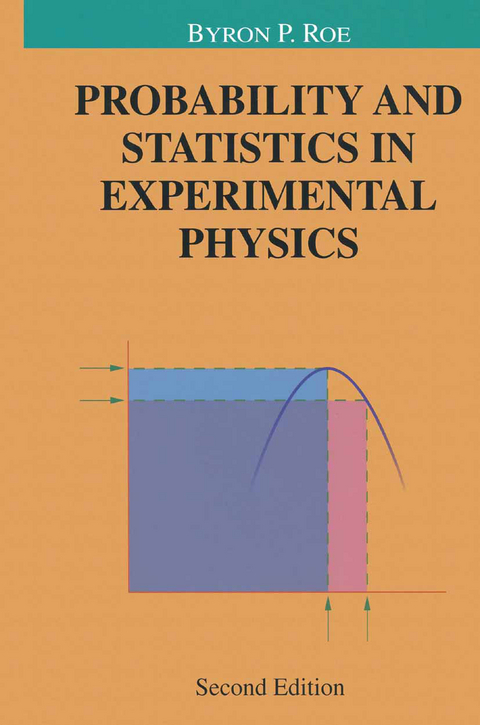
Probability and Statistics in Experimental Physics
Springer-Verlag New York Inc.
978-1-4419-2895-5 (ISBN)
1. Basic Probability Concepts.- 2. Some Initial Definitions.- 2.1 Worked Problems.- 2.2 Exercises.- 3. Some Results Independent of Specific Distributions.- 3.1 Multiple Scattering and the Root N Law.- 3.2 Propagation of Errors; Errors When Changing Variables.- 3.3 Some Useful Inequalities.- 3.4 Worked Problems.- 3.5 Exercises.- 4. Discrete Distributions and Combinatorials.- 4.1 Worked Problems.- 4.2 Exercises.- 5. Specific Discrete Distributions.- 5.1 Binomial Distribution.- 5.2 Poisson Distribution.- 5.3 Worked Problems.- 5.4 Exercises.- 6. The Normal (or Gaussian) Distribution and Other Continuous Distributions.- 6.1 The Normal Distribution.- 6.2 The Chi-square Distribution.- 6.3 F Distribution.- 6.4 Student’s Distribution.- 6.5 The Uniform Distribution.- 6.6 The Log-Normal Distribution.- 6.7 The Cauchy Distribution (Breit-Wigner Distribution).- 6.8 Worked Problems.- 6.9 Exercises.- 7. Generating Functions and Characteristic Functions.- 7.1 Introduction.- 7.2 Convolutions and Compound Probability.- 7.3 Generating Functions.- 7.4 Characteristic Functions.- 7.5 Exercises.- 8. The Monte Carlo Method: Computer Simulation of Experiments.- 8.1 Using the Distribution Inverse.- 8.2 Method of Composition.- 8.3 Acceptance Rejection Method.- 8.4 Computer Pseudorandom Number Generators.- 8.5 Unusual Application of a Pseudorandom Number String.- 8.6 Worked Problems.- 8.7 Exercises.- 9. Queueing Theory and Other Probability Questions.- 9.1 Queueing Theory.- 9.2 Markov Chains.- 9.3 Games of Chance.- 9.4 Gambler’s Ruin.- 9.5 Exercises.- 10. Two-Dimensional and Multidimensional Distributions.- 10.1 Introduction.- 10.2 Two-Dimensional Distributions.- 10.3 Multidimensional Distributions.- 10.4 Theorems on Sums of Squares.- 10.5 Exercises.- 11. The Central Limit Theorem.- 11.1Introduction; Lindeberg Criterion.- 11.2 Failures of the Central Limit Theorem.- 11.3 Khintchine’s Law of the Iterated Logarithm.- 11.4 Worked Problems.- 11.5 Exercises.- 12. Inverse Probability; Confidence Limits.- 12.1 Bayes’ Theorem.- 12.2 The Problem of A Priori Probability.- 12.3 Confidence Intervals and Their Interpretation.- 12.4 Use of Confidence Intervals for Discrete Distributions.- 12.5 Improving on the Symmetric Tails Confidence Limits.- 12.6 When Is a Signal Significant?.- 12.7 Worked Problems.- 12.8 Exercises.- 13. Methods for Estimating Parameters. Least Squares and Maximum Likelihood.- 13.1 Method of Least Squares (Regression Analysis).- 13.2 Maximum Likelihood Method.- 13.3 Further Considerations in Fitting Histograms.- 13.4 Improvement over Symmetric Tails Confidence Limits for Events With Partial Background-Signal Separation.- 13.5 Estimation of a Correlation Coefficient.- 13.6 Putting Together Several Probability Estimates.- 13.7 Worked Problems.- 13.8 Exercises.- 14. Curve Fitting.- 14.1 The Maximum Likelihood Method for Multiparameter Problems.- 14.2 Regression Analysis with Non-constant Variance.- 14.3 The Gibb’s Phenomenon.- 14.4 The Regularization Method.- 14.5 Other Regularization Schemes.- 14.6 Fitting Data With Errors in Both x and y.- 14.7 Non-linear Parameters.- 14.8 Optimizing a Data Set With Signal and Background.- 14.9 Robustness of Estimates.- 14.10 Worked Problems.- 14.11 Exercises.- 15. Bartlett S Function; Estimating Likelihood Ratios Needed for an Experiment.- 15.1 Introduction.- 15.2 The Jacknife.- 15.3 Making the Distribution Function of the Estimate Close to Normal; the Bartlett S Function.- 15.4 Likelihood Ratio.- 15.5 Estimating in Advance the Number of Events Needed for an Experiment.- 15.6 Exercises.- 16. InterpolatingFunctions and Unfolding Problems.- 16.1 Interpolating Functions.- 16.2 Spline Functions.- 16.3 B-Splines.- 16.4 Unfolding Data.- 16.5 Exercises.- 17. Fitting Data with Correlations and Constraints.- 17.1 Introduction.- 17.2 General Equations for Minimization.- 17.3 Iterations and Correlation Matrices.- 18. Beyond Maximum Likelihood and Least Squares; Robust Methods.- 18.1 Introduction.- 18.2 Tests on the Distribution Function.- 18.3 Tests Based on the Binomial Distribution.- 18.4 Tests Based on the Distributions of Deviations in Individual Bins of a Histogram.- 18.5 Exercises.- References.
| Erscheint lt. Verlag | 6.12.2010 |
|---|---|
| Reihe/Serie | Undergraduate Texts in Contemporary Physics |
| Zusatzinfo | XI, 252 p. |
| Verlagsort | New York, NY |
| Sprache | englisch |
| Maße | 155 x 235 mm |
| Themenwelt | Schulbuch / Wörterbuch |
| Mathematik / Informatik ► Mathematik ► Statistik | |
| Mathematik / Informatik ► Mathematik ► Wahrscheinlichkeit / Kombinatorik | |
| Naturwissenschaften ► Physik / Astronomie ► Astronomie / Astrophysik | |
| Naturwissenschaften ► Physik / Astronomie ► Theoretische Physik | |
| Naturwissenschaften ► Physik / Astronomie ► Thermodynamik | |
| Sozialwissenschaften | |
| ISBN-10 | 1-4419-2895-2 / 1441928952 |
| ISBN-13 | 978-1-4419-2895-5 / 9781441928955 |
| Zustand | Neuware |
| Informationen gemäß Produktsicherheitsverordnung (GPSR) | |
| Haben Sie eine Frage zum Produkt? |
aus dem Bereich


